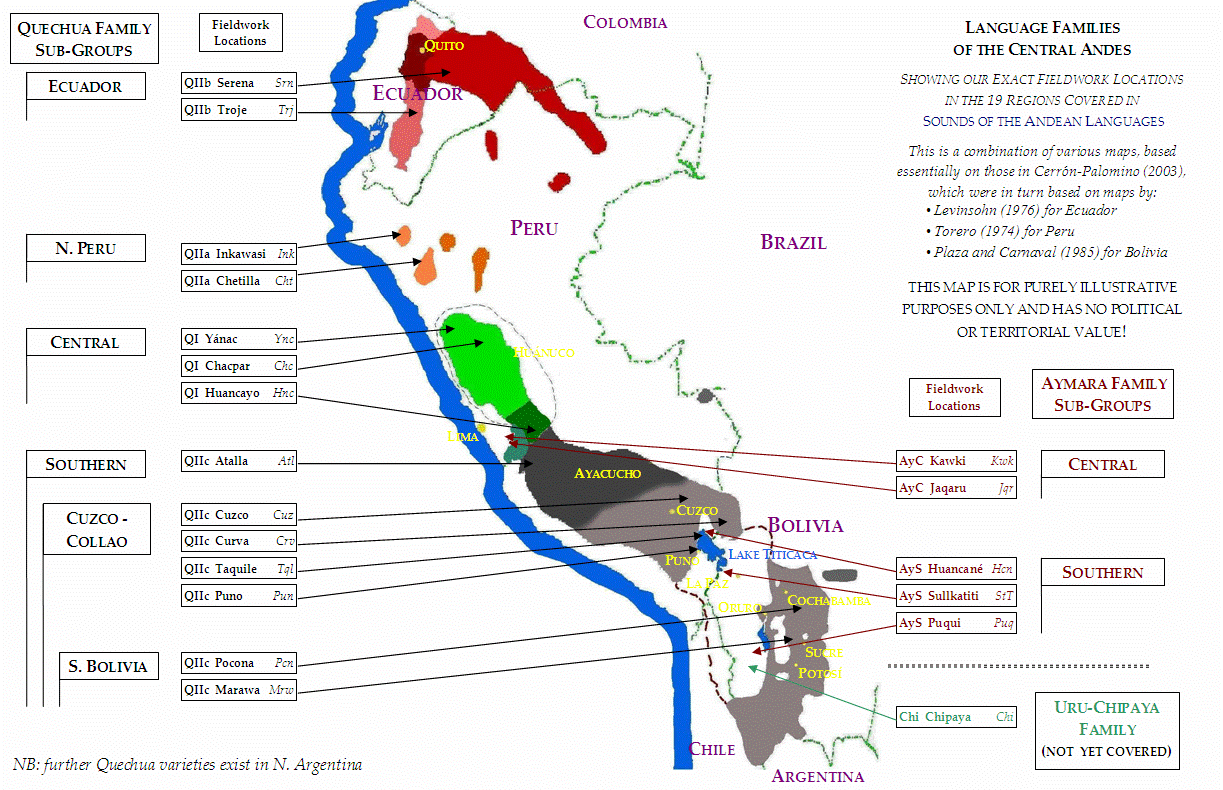Quechua
Languages and ‘Dialects’
Contents
What is Meant by the Term Quechua ‘Dialects’?
How Different are Quechua’s Dialects from Each Other?
Back to Contents – Skip to Next: What is Meant by the Term Quechua ‘Dialects’?
Maps of Quechua Dialects
There are a number of maps of Quechua dialects available on the web.
• My own map of Quechua dialects which appears below.
• A very detailed map at www.muturzikin.com.
• Another map of Quechua dialects at www.runasimi.de.
• If you’re looking for an idea of how different the dialects are from each other, you can compare sound recordings of them instantaneously online at our new website on the Sounds of the Andean Languages, or see a comparative table of phonological inventories of five main Quechua dialects.
•
You may also want to see a family
tree of Quechua, family
tree of Quechua – though be aware that this is a traditional
classification, and some of the details are still under debate between
linguists.

Back to Contents – Skip to Next: How Different are Quechua’s Dialects from Each Other?
What is Meant by the Term Quechua ‘Dialects’?
There are a great many different forms of Quechua (usually known as dialects, though in no way should this be taken in a disparaging sense), not all of which are mutually intelligible by any means.
For the full story, we now have a new website on the Sounds of the Andean Languages where you can find out much more about this and listen online to the main differences in pronunciation between 14 different regional varieties Quechua throughout the Andes.
We also have other resources, and a briefer introduction, in our section on Origins, History and Regional Variation in Quechua elsewhere on this website.
If you want the short story, read on for a very brief explanation (there’s also a version of this in Spanish) in answer to a query I received:
Is it fair to say that the various indigenous Quechua speakers are related in the way that all speakers of Italian dialects are related?
In the sense that they speak language varieties all derived from a single common source, yes indeed. All the dialects spoken in Italy (and in fact all the Romance languages too) have diverged over time, as Latin changed over time, but in different ways in different areas. Just the same natural process happened in Quechua, and the parallel to the source language Latin is in this case a language which linguists call Proto-Quechua (as vulgar Latin ‘is’ Proto-Romance for linguists). Unlike Latin, we have no written record of this language of course, but linguists can (as they already have done) work out quite a lot of details about it by tracing back from the diversity we know of among all the modern-day forms of Quechua that are all descended from it. This is known as ‘reconstructing’ the Proto-language (as far as is possible), according to what we know of typical processes of language change.
Back to Contents – Last section on this page.
How Different are Quechua’s Dialects from Each Other?
Latin has been diverging into the modern Romance languages for about 2000 years. Likewise the Quechua ‘language’/family has been diverging for between, at a rough guess (on the basis of how much divergence there is now), at least 1200 and maybe up to 2000 years or so.
The result, as with
Italian dialects, is that the most divergent forms of Quechua are now mutually
unintelligible, but there are some intermediate varieties whose speakers can
just about cope with all others. Some
linguists have put forward their (unquantified) impressions of how
different the most divergent dialects are from each other: as different as Spanish and Portuguese (Parker
1976a), or as Spanish and French (Weber 1989). I personally think
the former is not quite enough, the latter a bit too much, and would have said
Spanish and Italian! In a couple of
years the results of my current research project will be out, on precisely this question! I would rate Italian dialects as of the same
sort of order of divergence as Quechua – certainly given the extent of the
differences from